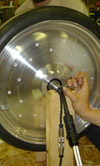Bearings go round and round
 SKF Automotive is well regarded for its work in NASCAR Sprint Cup Series competition, where it produces camshaft bearings used by major teams in this upper level racing.
SKF Automotive is well regarded for its work in NASCAR Sprint Cup Series competition, where it produces camshaft bearings used by major teams in this upper level racing.
Still, the Plymouth, Michigan manufacturer has interests beyond the scope of recognized motor sport. SKF is one of the major backers of the local University of Michigan solar-powered race car. The University of Michigan solar team’s Continuum competed in an 1800-mile race across the Australian outback in 2008
and placed first in the 2500-mile North American Championship – its fifth victory in nine races.
Currently the University of Michigan team is preparing for October’s World Championship race across Australia, hoping to become the first American squad to win the World Championship since General Motors’ entry won the inaugural, 1987 contest.
According to Kenneth C. Fegely, business engineer for SKF’s Racing and Engineering Services, this competition was an easy fit for his company. “We have been in the business of reducing friction and increasing efficiency for over 100 years,” he reminded me.
“We see the practical application of solar technology as one area of the future. It is not just the solar portion that interests us but the extremely efficient and clever use of the limited energy to get as much practical work as possible from it.”
The solar car has an in-hub electric motor with an efficiency of over 95 percent, according to Steven Hechtman, team leader for the Ann Arbor-based University of Michigan solar racing team. “Our team places a large focus on reducing any friction within the motor that would decrease this efficiency,” he said.
Working together since 2007, “SKF provides us with low friction deep groove ball bearings (DGBB) for our motor and wheels. These ball bearings exhibit extremely low amounts of friction, ensuring that the solar car is able to cruise with minimal resistance,” Hechtman explained.
The new Infinium race car has undergone more than 1000 miles of testing, using the hybrid DGBB with low drag seals. Because the drive wheels are the electric motors, “Our bearings are not only supporting the rotor; they also support the weight of the car and driver, and they handle the manoeuvring forces as well,” Fegely stated.
“When we first constructed our motor with SKF bearings, we were immediately impressed by the superior performance,” Hechtman told me. His previous edition motor without the SKF product was “only able to spin freely around its axle for a matter of seconds, while the new motor with SKF bearings spins for a number of minutes before coming to a rest.”
The Infinium solar racer is a three-wheeled vehicle with one drive wheel and two non-driven wheels, each with two DGBB’s. The bearings used on the [rear] driven rotor/wheel are a basic size 6206, which computes to 30x62x16 mm, Fegely told me. “The non-driven wheels use something smaller: a 6004 20x42x12 mm bearing.
“These are a Hybrid deep groove ball bearing with low drag seals, low drag cage, special internal clearance and wide temp lubricant. We chose the bearing specifically for its load carrying capacity and excellent rolling characteristics.” The hybrid term designates a steel ring with ceramic rolling elements. “The silicone nitride balls are harder, lighter and require less lubricant to operate than a standard conventional all steel bearing.”
Despite being comprised of dissimilar materials (steel and ceramic), the bearings have no tendency to micro-weld to each other under loading, as occurs with steel on steel. “This reduces the requirements of lubricant and allows a lower viscosity lubricant to be chosen, helping reduce parasitic losses due to the grease,” Fegely explained. “The low drag seal strikes the right balance of keeping contaminants out, yet reducing friction due to seal lip contact.” It is not possible to run the bearing without a seal, as the vehicle operates in all environments during competitions.
During the Australian race, vehicles travel through the outback where they are subject to dust storms and temperatures of 110°F. Although the race route itself is fairly straight, competitors do need good cornering capability during qualifiers for the race, which occur at the Hidden Valley Speedway, a road course where Australian V8 Supercars compete. They also test their car at NASCAR tracks like Michigan International Speedway, though the American Race is also on stretches of long, flat roads.
Will this technology morph into mainstream motorsport? While many aspects of the DGBB could transfer to another racing application, Fegely believes it is the “process that you use exactly what you need for the requirements,” that should be paramount in choice. “What works great in a solar racer may well fair miserably in a rally car – although some of the features like ceramic balls, low drag seals – may transfer over nicely.”
With service life of 5000 miles and most solar races being conducted in half (or less) that distance, the DGBB as used in the University of Michigan solar Infinium race car performs the three jobs any bearing is subjected to: support, locate and reduce friction. We will have to wait until October to see how it fares in this competition.
Written by Anne Proffit.